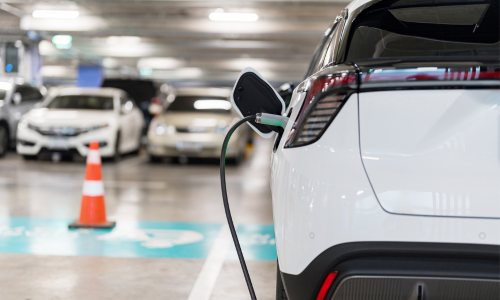Over 500 local governments in Canada have declared climate emergencies and are looking at switching to electric fleet vehicles (EVs) to reduce their transportation emissions. However, the path to fleet electrification has its challenges. Procurement costs, supply chain disruptions, limited suitable vehicles and inadequate charging infrastructure are just a few of the barriers municipalities face. Despite these obstacles, some cities are crafting unique solutions and taking innovative steps to scale up their electric vehicle fleets.
Clean Air Partnership and the Federation of Canadian Municipalities have developed an EV Fleets Case Study series to showcase unique approaches adopted by the City of Kingston, ON, the District of West Vancouver, BC and the City of Calgary, AB, to scale up their EV fleets.

Faced with technological barriers and supply chain issues, Kingston adopted a leasing model to acquire EVs. This model allows for the testing of vehicles before committing to purchase, trials of various makes, models, and technology, and helps drivers overcome range anxiety. The 10-year leasing agreement is expected to save the City approximately between $11,000 and $17,000 per vehicle (depending on the make and model of EVs) compared to an outright purchase and is expected to reduce their carbon emissions by approximately 41 metric tons of CO2 per year.
West Vancouver’s path to fleet electrification involved electrical capacity upgrades at two key municipal facilities to support the installation of Level 2 chargers. The District has now installed the first phase of chargers, with two EV-ready facilities and is ready to add additional chargers in the future. A 5-year EV Supply Equipment (EVSE) contract maintains and manages the charging stations. The District also adopted a Green Fleet Purchasing Policy to prioritize EVs and introduced a comprehensive fleet management program to ensure the successful integration of EVs into the fleet. West Vancouver has adopted an environmental levy to fund its ongoing EV procurement and charging infrastructure investments.

Despite facing barriers in procuring electric vehicles (EVs), Calgary has managed to acquire over 30 light-duty EVs and two electric ice resurfacers in the past two years. Calgary’s transportation staff developed the Green Fleet Strategy aimed at acquiring 300 EVs between 2023-2026, which would make up 25% of their light-duty fleet. Staff overcame procurement barriers by developing a Green Option Procurement Strategy. The City purchases renewable electricity, reducing emissions from 170.6gCO2e/km for conventional vehicles to effectively 0 for EVs. Fleet staff estimate achieving emissions reduction of 2400tCO2e/year by 2026 by switching 25% of light-duty vehicles to EVs (excluding emissions from manufacture and disposal). Fleet electrification has also changed the perception of staff, and more fleet operators are switching to EVs as their personal vehicles.
Check out these case studies to learn more!
Case Study – Calgary
You can also join us for an informative panel discussion at 1:00 pm Eastern time on February 23rd with staff from the City of Calgary, District of West Vancouver and EV Fleet experts from the Region of Peel and Halifax Regional Municipality to learn more about these case studies and get answers to all your questions. Register for the panel today.
By Devanshi Kukadia, Climate Communications Lead